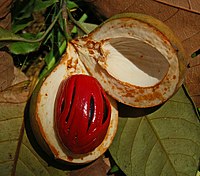
Photo from wikipedia
Main conclusionThe new model orange callus line, similar to carrot root, was rich in carotenoids due to altered expression of some carotenogenesis-associated genes and possessed unique diversity of chromoplast ultrastructure.Callus… Click to show full abstract
Main conclusionThe new model orange callus line, similar to carrot root, was rich in carotenoids due to altered expression of some carotenogenesis-associated genes and possessed unique diversity of chromoplast ultrastructure.Callus induced from carrot root segments cultured in vitro is usually pale yellow (p-y) and poor in carotenoids. A unique, non-engineered callus line of dark orange (d-o) colour was developed in this work. The content of carotenoid pigments in d-o callus was at the same level as in an orange carrot storage root and nine-fold higher than in p-y callus. Carotenoids accumulated mainly in abundant crystalline chromoplasts that are also common in carrot root but not in p-y callus. Using transmission electron microscopy, other types of chromoplasts were also found in d-o callus, including membranous chromoplasts rarely identified in plants and not observed in carrot root until now. At the transcriptional level, most carotenogenesis-associated genes were upregulated in d-o callus in comparison to p-y callus, but their expression was downregulated or unchanged when compared to root tissue. Two pathway steps were critical and could explain the massive carotenoid accumulation in this tissue. The geranylgeranyl diphosphate synthase gene involved in the biosynthesis of carotenoid precursors was highly expressed, while the β-carotene hydroxylase gene involved in β-carotene conversion to downstream xanthophylls was highly repressed. Additionally, paralogues of these genes and phytoene synthase were differentially expressed, indicating their tissue-specific roles in carotenoid biosynthesis and metabolism. The established system may serve as a novel model for elucidating plastid biogenesis that coincides with carotenogenesis.
Journal Title: Planta
Year Published: 2018
Link to full text (if available)
Share on Social Media: Sign Up to like & get
recommendations!